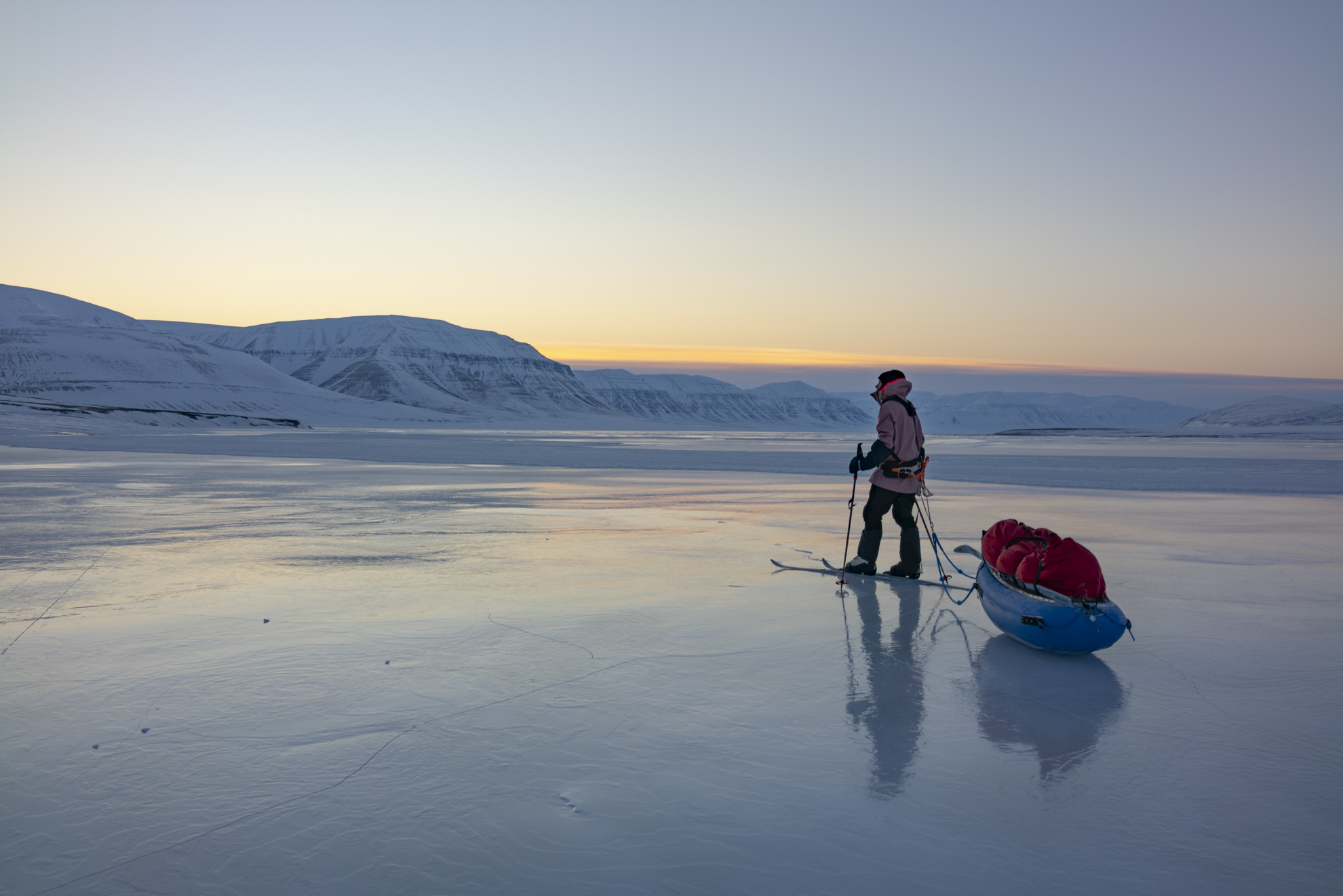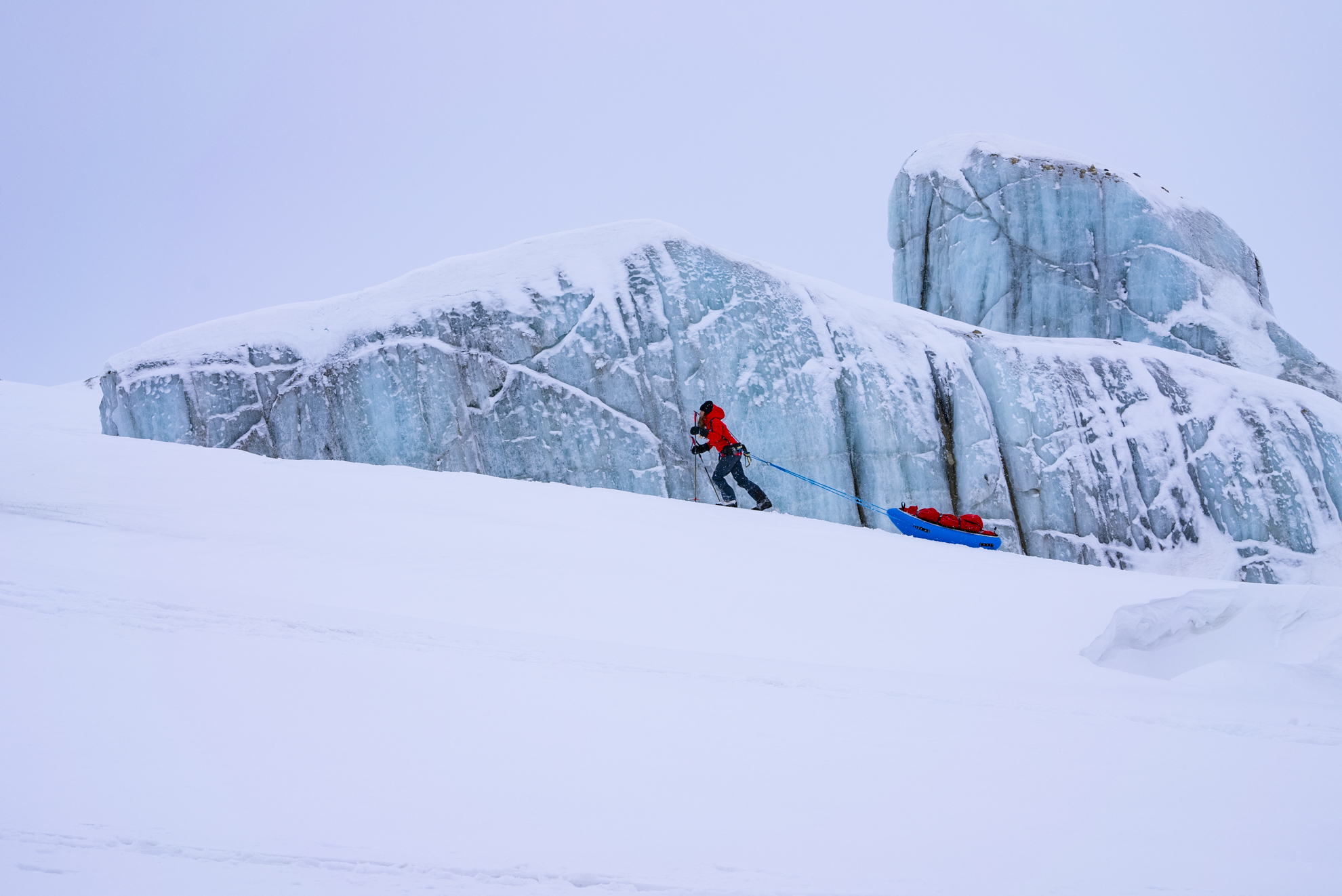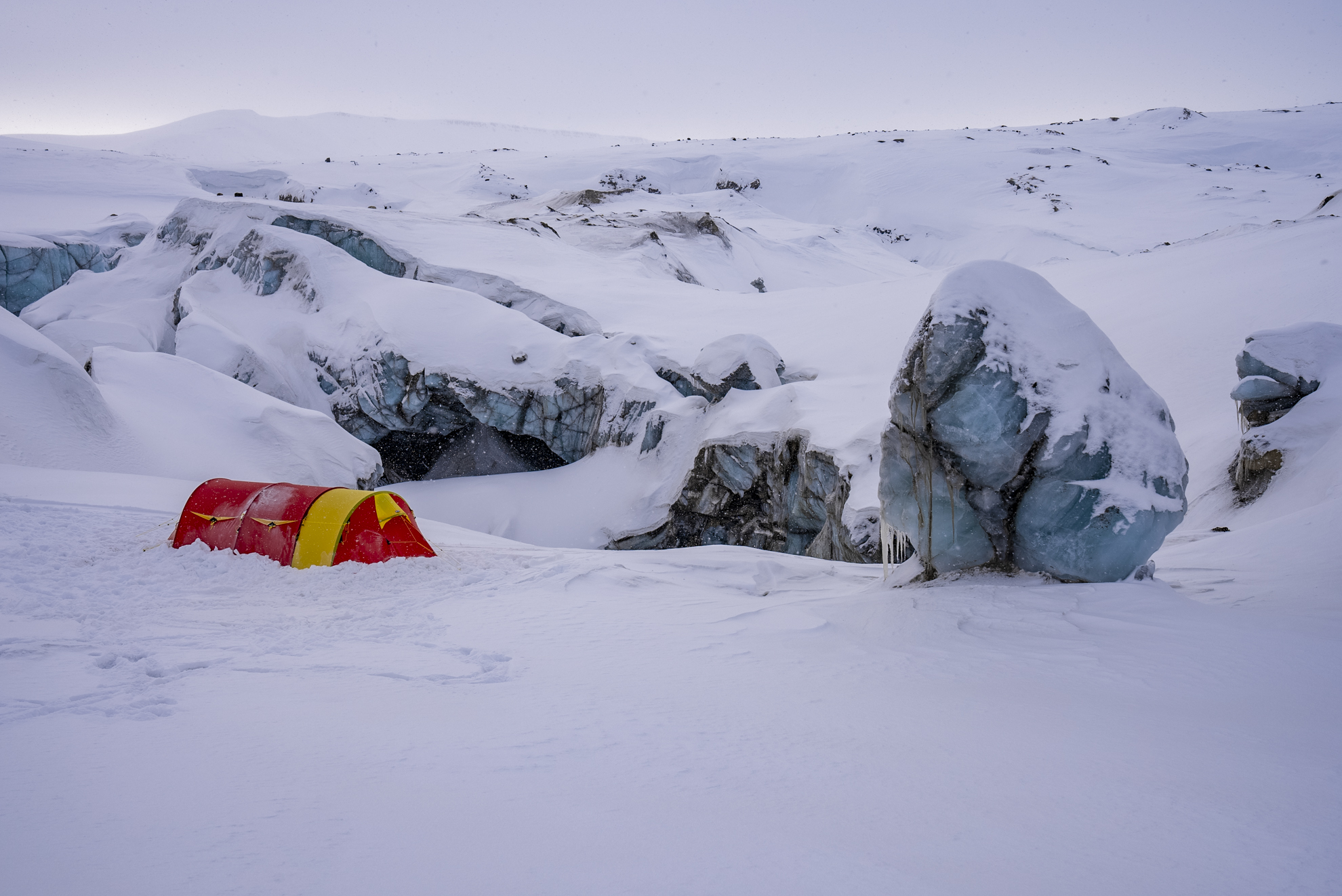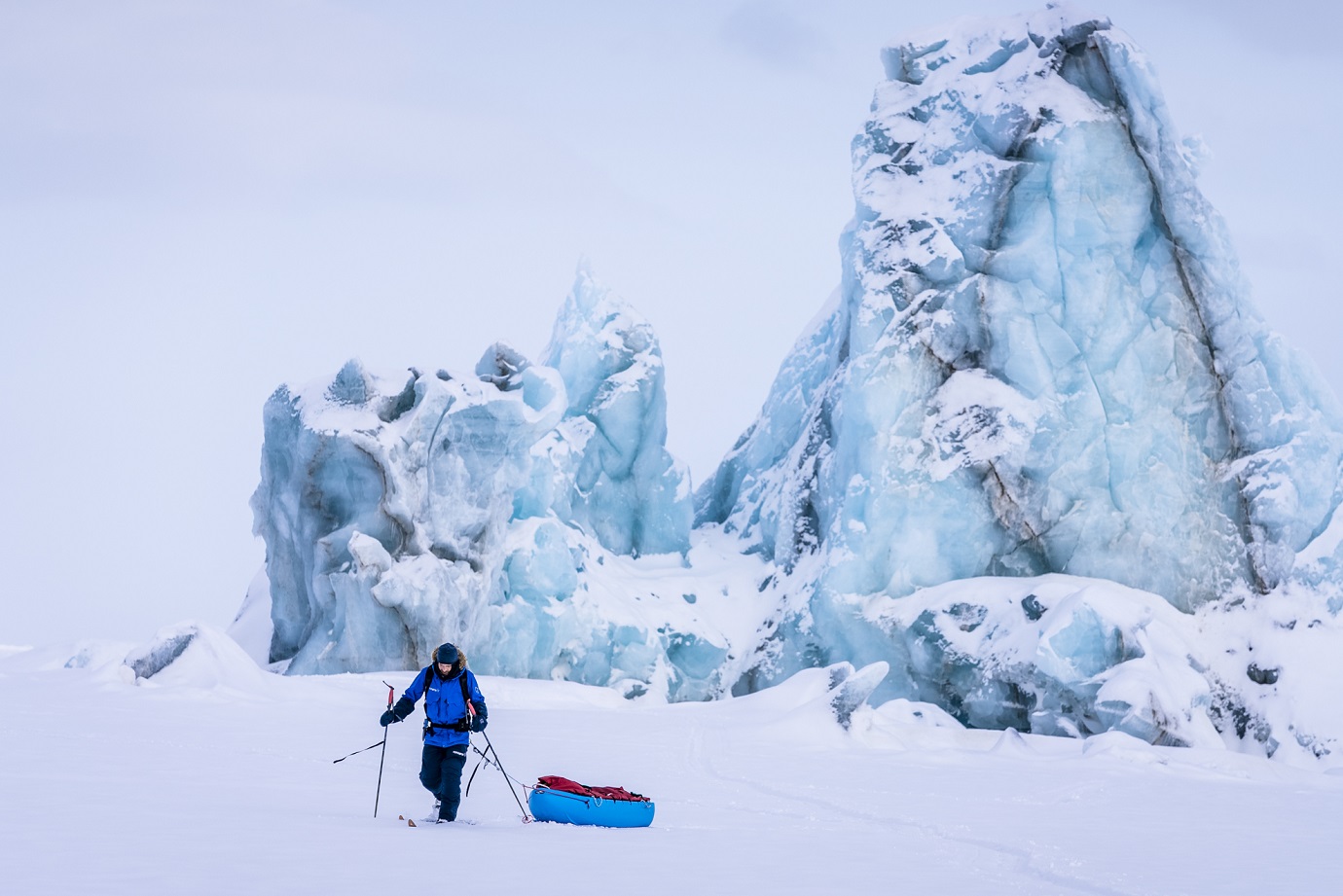POLAR SHADOWS
First full winter traverse, from North to South, of Spitsbergen.
1123km, 63 days, unsupported.
April 15th 2021, Longyearbyen, Svalbard.
It was the 2nd of February 2021 when my partner, adventure filmmaker and ultra-marathon athlete Caroline Côté, and I set off on an intensely challenging, winter crossing over the vast and rugged territory of Svalbard. For more than 2 months, crossing over 1100km and being 100% self-sufficient, we had to tap into our highest endurance and perseverance levels to achieve the goal we set ourselves.
Our goal: to be the first expedition to cross the main island of Spitsbergen, from North to South during the peak of the polar winter. Leaving from the town of Longyearbyen, which would also be our point of return, we chose to shun the help of any motorized vehicles to reach the extreme north point of the island, setting out on our skis. This was an extraordinary expedition with the risk of endangering our lives, and in turn the love that unites us!
Longyearbyen, the administrative capital of Svalbard, and the most northern town in the world, would be the departure point. After picking up any last-minute parcels, we quit civilization and dove into our big adventure of 63 days, pulling 2 sleds each, weighing in at more than 290kg. We were ready to meet the ‘King of Svalbard’, the polar bear. The possibility was high as Svalbard is home to approximately 3,500 polar bears, a third more than the number of habitants on this archipelago. We would also encounter the famous and emblematic Svalbard reindeer, along with the arctic fox which is now sadly an endangered species on the island. We would be traveling through the heart of the polar night with only each other’s company, relying heavily on our navigation instruments to progress, the moon and stars on clear nights, and the beams of our headlamps. We knew that poor visibility during the polar nights could be an ongoing challenge and that eventually, as the month of March drew closer, the light would make its return and guide us to the South, hopefully under rays of a returning sun.
This itinerary, of over a 1000km, was not without numerous challenges that we had to overcome!

The polar nights left little room for error. The possibility of coming nose to nose with a polar bear was constant. We came across 2 ‘Kings of Svalbard’ during their expedition. The unpredictable, strong winds across the glacier and along the fjords meant that temperatures dropped dramatically. (The topography of the island has changed as a consequence of global warming). We found the southern glaciers to be strewn with dangerous crevasses in this changing environment. Hunger was a major challenge during our traverse, and it haunted us from the beginning to the very end of the expedition. We had to ration for a good part of our journey to make it to the next pick-up point. It left us hungry and weak towards the end of the expedition and laying eyes on our thin silhouettes upon arrival, we realised to what extent! Our strength came from witnessing the sheer beauty of the ice world we were exploring, from the Northern lights to the glaciers.
The success of this insane expedition was marked by celebrity Norwegian, polar explorer Børge Ousland. Upon our return to civilization, Børge was there to greet and congratulate us in person for our feat. Børge, with whom I had experienced several expeditions to date, was interested to hear all the details of our adventure!
The meeting. We met on a ski expedition in Antarctica. Caroline was the film maker, and I was the guide. Late one evening, while the other participants were sleeping, we found ourselves together, alone outside the tent. Sitting in the middle of the glacial mountains in the Antarctic Peninsula, facing the Pacific, we shared a cigarillo and decided to join forces!
Bio Vincent Colliard. With a penchant and lifelong passion for exploration, French adventurer Vincent Colliard (35 years old), is one of the most accomplished polar explorers of our generation whose numbered expeditions include the current crossing of the 20 largest icecaps on earth – Ice Legacy. He represents a new breed of athlete, bridging adventure and science, inspiring the environmental dialogue on a global scale.
Bio Caroline Côté. In addition to working as an adventure filmmaker and photographer, Caroline is a Canadian adventurer and an ultra-marathon runner. She runs up to 160 km in one stretch, travels 2000 km alone in her native Quebec in 74 days, explores the little-known regions of Antarctica on her own and paddles along the Yukon River to meet the Alaska First Nations. She is a very versatile person with an extraordinary mindset. When she is behind the camera, her mission is to engage people in learning more about nature conservation and surpassing oneself. For more details visit: https://en.caroline-cote.com/

Memorable moments from the expedition:
2 nd February: departure from Longyearbyen into the heart of the obscurity of the Arctic Winter! 290 kg, the total weight of the sleds between Caroline and I.
5th February: we see the gaze of green eyes upon us in the night…a bear or a reindeer?
10th February: we leave the ice cap Filchner (30c with strong Easterly winds); which left us withfrostbite. We arrived at Widje Fjord, which they followed to reach the Northern tip of the island.
14th February: we get stuck at Widje Fjord and cannot go any further North due to:
• lack of ice;
• not enough snow surrounding the fjord (too rocky, so no good for the sleds);
• we have to turn back and return to the ice cap Filchner!
15th February: we set off again. We meet a polar bear and ski approximately 100m alongside this majestic creature. After about 10km, we head into a valley, towards ‘Smuts’ glacier.
16th February: we head upstream on a partially frozen river and find ourselves ascending 1000m heights in the middle of the beautiful Atom Fjellet mountains.
19th February: got a brief glimpse of the sun for the first time on the ice cap known as Åsgardfonna.
22nd February: after a sturdy push of 42km, we reach Verlegehuken, the Northern point of the island. This will be the starting point of the 1st Winter crossing of Spitzbergen, North to South unsupported. Our objective; to reach the Southern tip before the 21 st March – the first day of Spring.
15th March: it’s -38° in the tent this morning, pitched on the glacier called Hamberg. Lars Ebbessen announces a huge mass of warm air approaching soon. The adventurers push on, aiming to reach the Southern tip asap!
18th March: crossing Isbukta Bay (Ice Bay in Norwegian). 11km of pack ice in a straight line! The weather is warm, it’s strangely calm whilst we cross the bay. A cloudy front is progressively approaching. At the end of the day, the weather worsens. We stopped to set up camp. We must work quickly before the weather front arrives and makes things difficult.

Night of 19th March: Caroline wakes up and realizes that the tent is buried in snow. The pair shovel until the morning! Before setting off again, we allow ourselves a quick siesta of 50 minutes; we are exhausted and yet so close to our goal! Less than 40km separates us now from the Southern tip of Svalbard. The inside of our tent is humid and it is 0°c, nearly 40° difference from 3 days prior. We must put all our material into our vapor barrier bags (like a bin bag that they sleep in each night to protect their sleeping bags), without which the condensation transforms into ice! We had not brought waterproof bags with them unfortunately. We had never known such extreme changes in temperature before. We get back on our skis and carry on, the fatigue leaving us feeling like zombies. Only 12km covered and the weather brings them to a halt once again.
20th March: “You guys should go early in the morning! It’s going to get bad later!” We read the short message and hurry to leave the ice cap Sorkappfonna. Despite some difficulties packing the tent (the hoops are totally iced over), today is the day we must give our all to reach Sørneset, the Southern tip of the island. It’s the last day of Winter, the wind picks up and the clouds are rolling around the tips of the mountains. The situation gets dangerous to the point that we can no longer stand up straight on the moraines of the glacier Matthiasbreen. With such strong winds, there is no option but to stop pulling the sleds! We head South, leaving the zone we were in quickly, and readjust our itinerary in order to reach Sørneset. A mass of threatening clouds is forming off the South Cape, and on the right, a sea scattered with ice is being violently blown by the wind!
20th March, 13h15: We did it. After 47 days of expedition unsupported and 27 days after leaving the Northern point of Verlegehuken. At 13h15, we made it to the Southern tip. The first crossing of Spitzbergen, North to South in Winter unsupported.
In a haze of fear, joy, and exhaustion, we sit down, positioned just under the cairn of Sørneset, protected by an emergency cover! We share our position on the GPS. We had managed our goal
Unfortunately, we then had to wait 4 days at the South Cape before heading back North. Outside the weather is menacing.
24th March: we resume our journey. 250km away from their final destination Longyearbyen.
25th March: Another diversion! To our great surprise, the ice of Isbukta is completely fractured, giving way to open waters – a deadly trap without dry suits or rafts at the ready. At the end of the day, we find ourselves roped up in a delicate passage called Isryggpasset and navigate our way in view of the bright blue seracs.
26th March – 4th April: due to violent winds we cover only 7km on this day. We are at our lowest.
Due to lack of sleep and calories, we have no energy and are feeling weak. A last blast of wind with gusts of 30m/s as we approach Longyearbyen. “We were bitten right to the end. We made it.”
5th April: we ski the last 4km. Heads down and without many words to exchange, we try to realize the magnitude of our achievements.
10th April: Norwegian Polar Explorer Børge Ousland came to greet and congratulate us!

MAP OF THE EXPEDITION ROUTE







